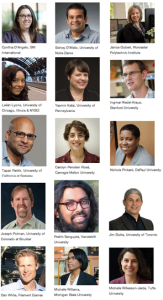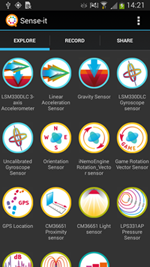CIRCL News
On March 26 and 27, 2014, CIRCL hosted an intensive two-day Partnering for Impact (P4I) workshop that assembled a diverse group of 49 cyberlearning researchers, entrepreneurs, teachers and school leaders, and government and foundation decision makers to identify ways to work together to achieve deep, broad, and important educational impacts. This meeting was just the start; if you would like to join a working group around P4I, or have suggestions for other working groups, contact CIRCL. For example, CIRCL is matching up people up for a cyberlearning symposium for AERA. Let us know if you’d like to be involved. At the Cyberlearning Summit (see articles below), there will also be breakout sessions for working groups on a variety of topics.
Cyberlearning Summit Update: Program, Speakers, & More
The 2014 Cyberlearning Summit is less than a month away! The Summit aims to build a community of professionals that can accelerate advances in the design, study, integration, and scaling of learning and teaching mediated by innovative learning technologies. Researchers, designers, educators, developers, policy makers, and other stakeholders will descend upon the Memorial Union of the University of Wisconsin at Madison’s campus on June 9 and 10 to share their latest research on ways to effective study and support learning and teaching with technology. The Summit features 15 keynote talks, research posters, and technology demonstrations. In-person registration is closed due to space constraints, but virtual participants can tune in to a live webcast to hear talks and join online activities with other online participants. Visit the 2014 Cyberlearning Summit page for more details on the Summit program, speakers, hotels, and virtual participation.
Summit Webcast and Virtual Participation
If you are not attending the Summit in person, you can register for the online program to view the live webcast of talks and join online activities with other online participants. Please invite your graduate students, staff, and colleagues to join the virtual program. We also encourage you to view the webcast face-to-face in a group setting — reserve a conference room at your University or place of work for groups or classes to come and watch a talk set (or more) together in real time. Web conferencing software will also be available for talking with other virtual participants. At least one remote group (in Finland) plans to create a video reflection of their thoughts about the talks. If you’d like to contribute in a similar way, or can volunteer to help us with online facilitation in the web conference during the Summit, contact CIRCL. See the virtual participation information page for more details.
NSF Cyberlearning Integration (INT) Proposal Webinar
CIRCL will host a webinar on Monday June 2, 2014, from 3-4pm EDT, on the current Cyberlearning and Future Learning Technologies solicitation. This webinar will be geared towards those individuals seeking to submit Integration proposals, due July 14, 2014. Integration projects intend to “integrate several technologically-sophisticated efforts that have already shown promise, incorporate promising technologies and their uses into the lives of learners or organizations, or extend a promising innovation in ways that would allow it to be used by a larger population or variety of learners, and to answer foundational research questions related to learning that can only be answered in the context of an integration such as that proposed”. This upcoming webinar follows the highly-attended February solicitation webinar that was geared towards EXP and DIP proposals. Register to attend the INT webinar on June 2.
Featured Perspective: Meet Stephanie Teasley
Stephanie Teasley is a research professor in the School of Information at the University of Michigan.
How does working in a School of Information relate to the Learning Sciences?
Although I am trained as a cognitive and developmental psychologist, I’ve worked most of my career in a School of Information. I love the inherently interdisciplinary nature of a School of Information — and we’re very into using multiple methods. Schools of Information have immense expertise in data science and big data, in informational visualization, in designing user interfaces, in information architecture and retrieval, in data policy and security, and in curating resources — but as Learning Scientists we bring in data that is not typically the focus in Schools of Information. We need to work together to interpret big data in terms of learning processes and in order to recommend tools and resources that could improve students’ lives.
What is the key to productive interdisciplinary work?
Complementary expertise and an ability to see past doctrines. There are so many stovepipes in academia. The early days of learning sciences were exciting because we didn’t have those borders, but as we’ve matured, we are starting to draw boundaries around how we define learning sciences research, around methodological approaches, and around contexts for learning… There is a majority of work in STEM K-12, for example. I am excited about opening up learning sciences work in higher education, to connecting out of school and in school learning, and to more research in informal contexts. I want to see a continued openness in our community, because that’s where we will see deep innovations.
Why is Learning Analytics important to the future of research on Learning?
When I first began studying processes of learning, we had to hand-code students’ discussions — that was very slow, laborious work, and we lost a lot of context in the process. Then we started videotaping students and simultaneously capturing logs from the software simulations they were using. Now we could integrate discourse with the context of the discourse, and there was real joy and beauty in process of analyzing learning — but it was still laborious, so we could only work with 10 or 20 students’ data at a time.
When I realized how much data was being captured by our Learning Management System at Michigan, I became excited because we could be studying tens of thousands of students, not just 10 or 20. But to do that, we have to realize that much of the data which is automatically collected isn’t that interesting — for example, the mechanics of turning in assignments. But there is enough in online discussions, wikis, and use of other rich learning tools that could help us better understand learning — and now we can look for patterns that might be important not just with 10 or 20 students, but potentially to 10,000 students — and not just for an hour or two, but over the course of years while they attend a university. So if we find meaningful indicators of learning processes and see how these patterns vary across students, we can potentially design learning experiences that benefit huge numbers of students.
If I’m a University President, a voter, or a congressperson, why should I care about Learning Analytics?
While issues of data privacy are very much on people’s minds today, it’s important to recognize that using big data doesn’t mean becoming Big Brother- it can become a means for understanding how to tailor learning experiences to meet the needs of every student. In my own work, I love having access to data from a whole campus– we can look at WHO is benefiting and so we can look at equity. For example, are first generation college students having a different experience from those whose parents went to college? We’re combining what we know from learning theory with indicators in the data and other contextual information we know about students at our university — and finding ways to expand opportunities to learn. For example, we might know that students who log in to the campus LMS four times per week get a better grade than those who only log in twice. But simply telling students to log in more often won’t solve the problem — rather, should we be organizing the learning environment to support spaced practice? or do the course activities need to be designed to attract more frequent engagement by diverse students? Learning analytics allow us to ask and answer questions like these, and generate actionable insights into learning.
Opportunities
FabLearn 2014 invites submissions for its fourth annual Conference on Creativity and Fabrication in Education to be held on October 25-26, 2014 at Stanford University.
Applications for the 3rd Annual Learning Science Workshop, Research and Innovation for Enhancing Achievement and Equity, June 14-15 at Carnegie Mellon University, are due May 15, 2014.
Register for the June 19th Youth Motivation Webinar: Findings from ITEST to learn about strategies, successes, and challenges in fostering and assessing youth motivation and STEM career interest.
Science Learning+, a program type in the new AISL Solicitation, will provide up to $14.4 million to support research into how learning happens outside the classroom, exploring the most effective practices and building the evidence base in this area. Planning Grants (proposals due July 10, 2014) will enable initial collaboration and ideas development. Partnership Grants (due in 2015), will fund research activities for up to five years.
Resource & Tech Corner
ISLS NAPLeS webinars, led by experts in the field of learning science, address a variety of topics such as assessment and evaluation, cognition and metacognition, and physiological measures in learning sciences. Join an upcoming webinar or view archived recordings.
The new book Learning Online: What Research Tells Us About Whether, When and How by Barbara Means, Marianne Bakia, and Robert Murphy synthesizes research findings on the effectiveness of different types of online learning and describes research about how best to implement different forms of online learning for specific kinds of students, subject areas, and contexts.
Read an interview with Connie Yowell, Director of Education for U.S. Programs at the MacArthur Foundation, on digital media and learning, how it has changed over time, and where it’s headed.
A new app called Sense-IT developed by nQuire is available on Google Play. Sense-IT opens up all the sensors on Android phones and tablets for data logging, citizen science, inquiry learning, fun. If you have feedback on usability or suggestions for science learning activities using the sensors (e.g. ‘find the fastest lift in the country’, or ‘create a noise map of your area’), contact Mike Sharples. nQuire is now working on a new ‘missions’ site for young people to set crowd-sourced inquiry science challenges and missions.
Check out TutorIT and AuthorIT, an adaptive tutoring system and authoring platform for creating adaptive tutors.
Share Your News
Have some news (project highlights, job opportunities, RFPs, calls, etc.) that you want to share? Contact CIRCL.
CIRCL is supported by NSF grant IIS-1233722 (CRC: Center for Innovative Research on Cyberlearning (CIRCL). Any opinions, findings, and conclusions or recommendations expressed in this material are those of the author(s) and do not necessarily reflect the views of the National Science Foundation.






